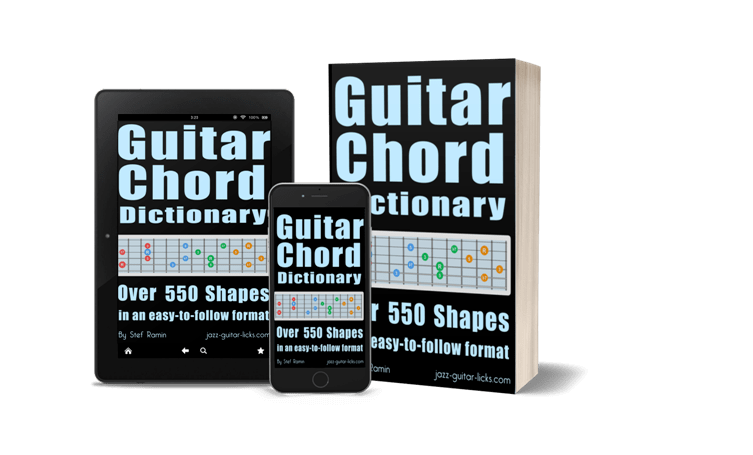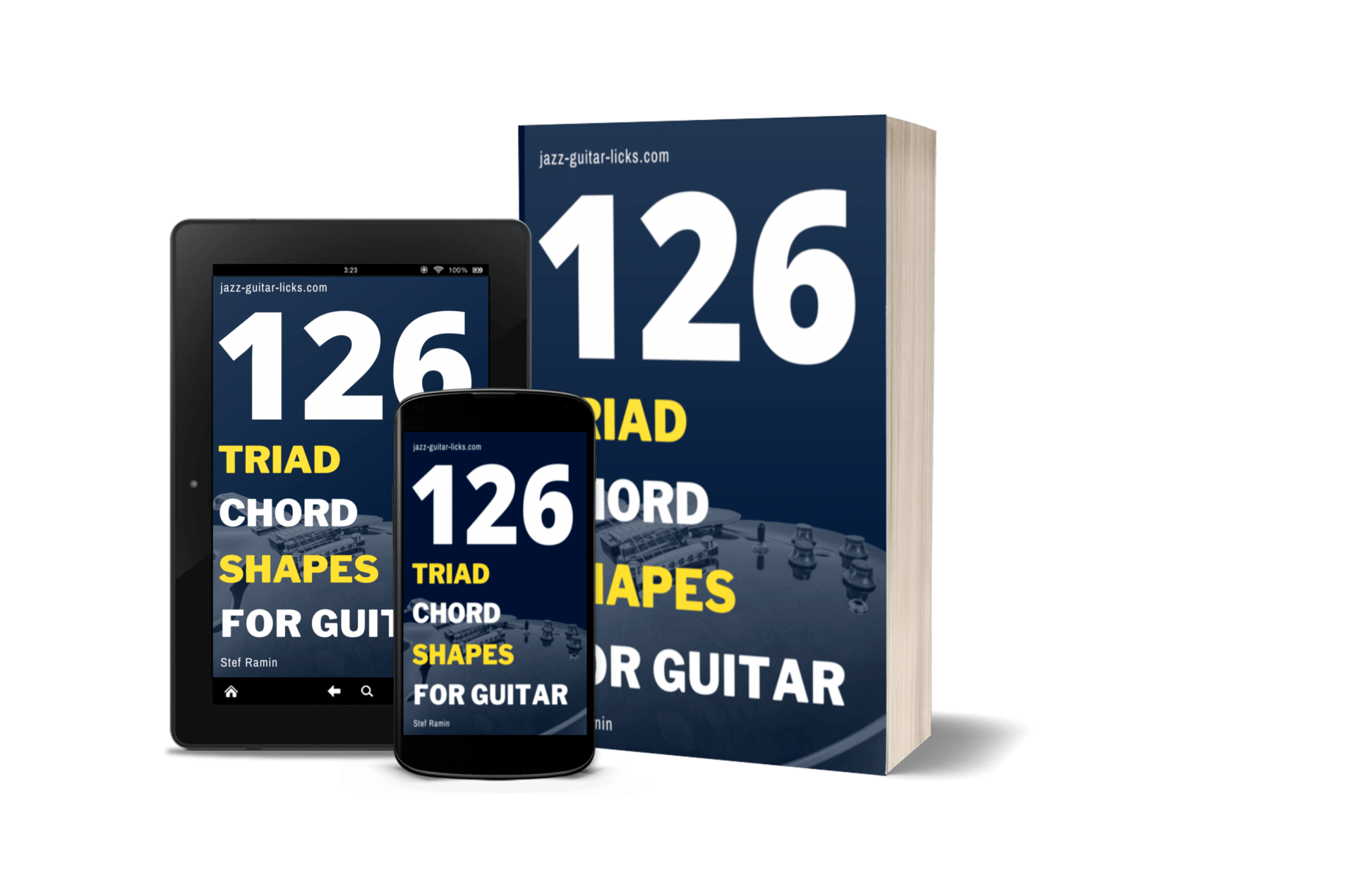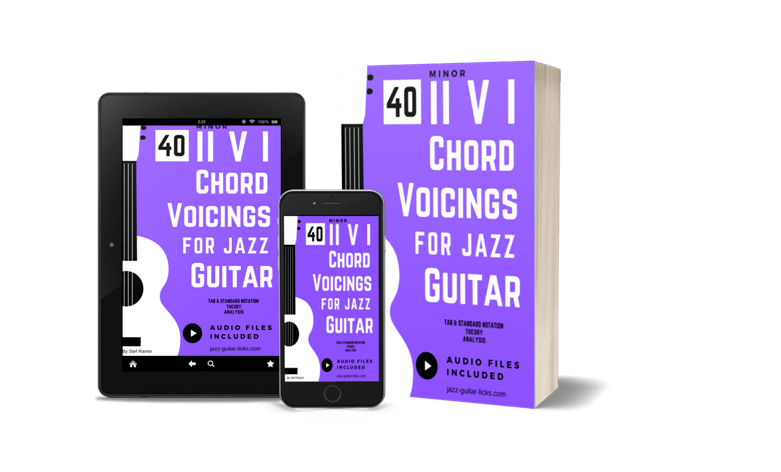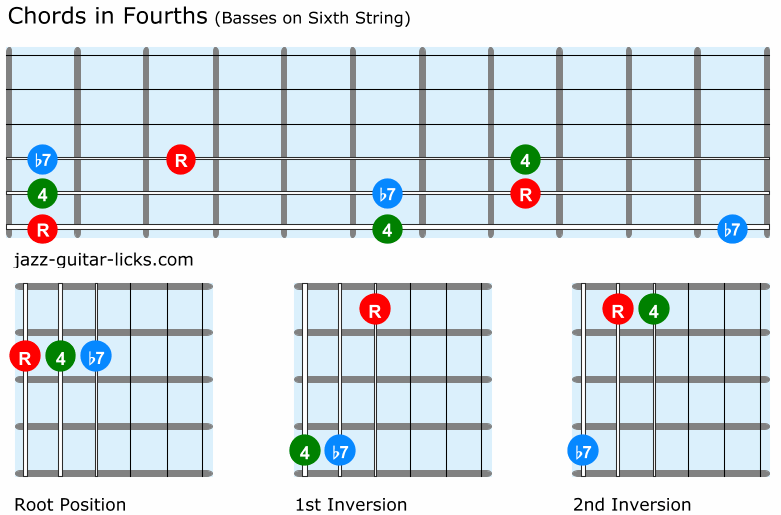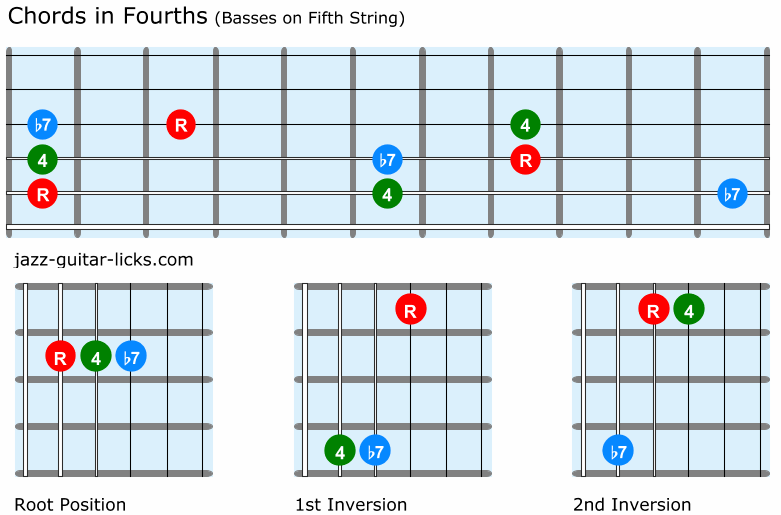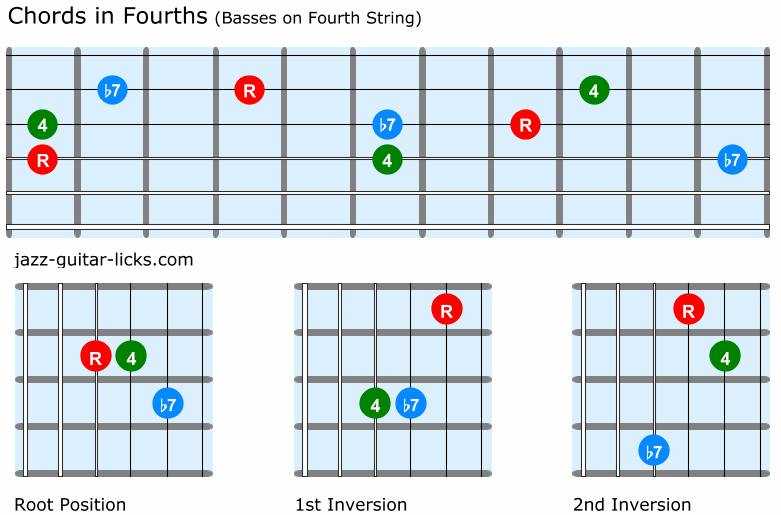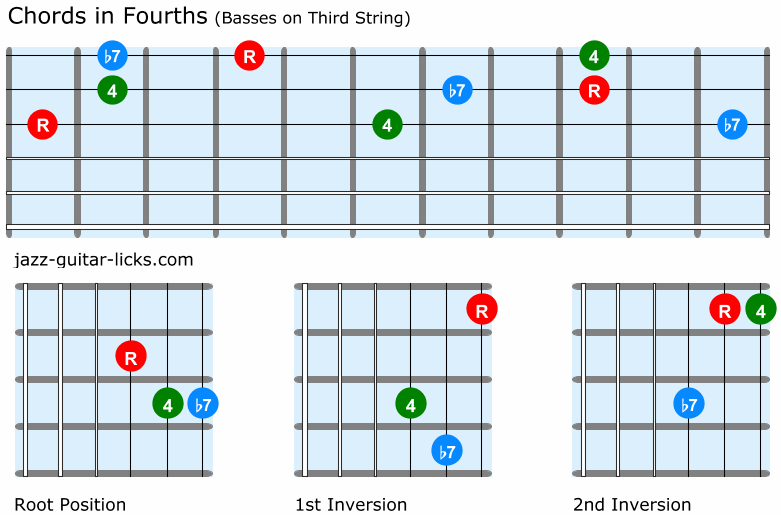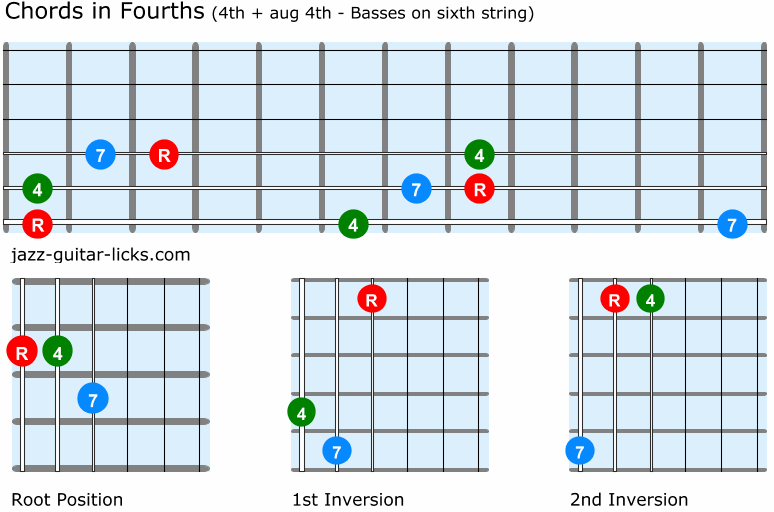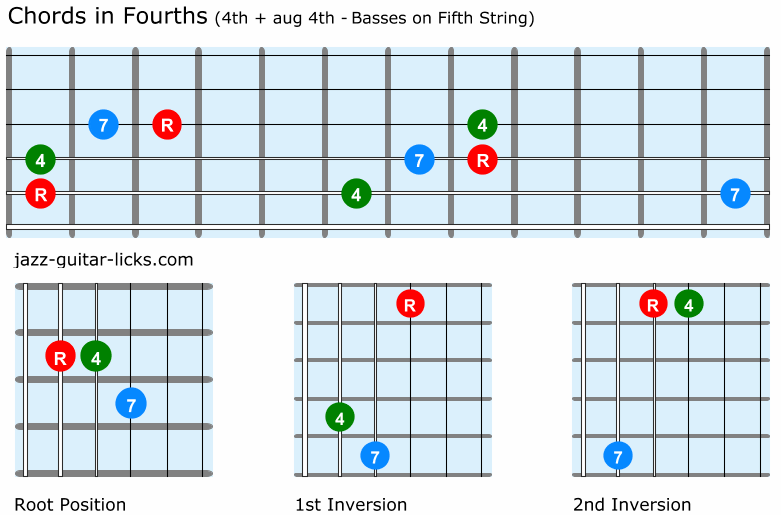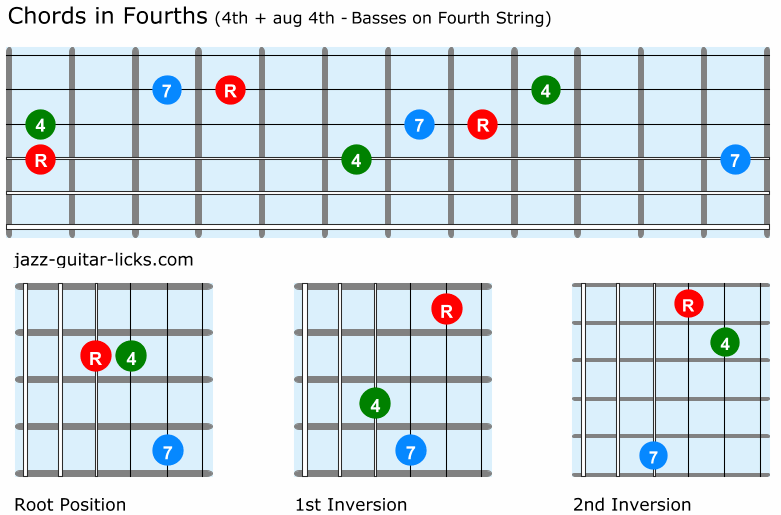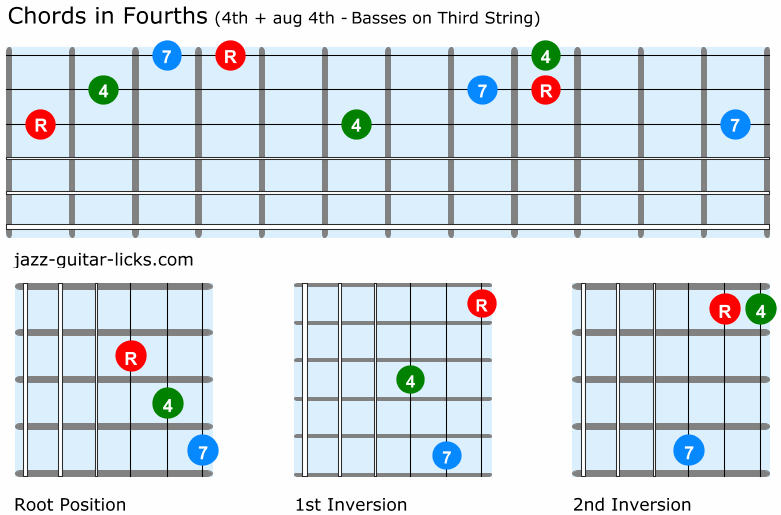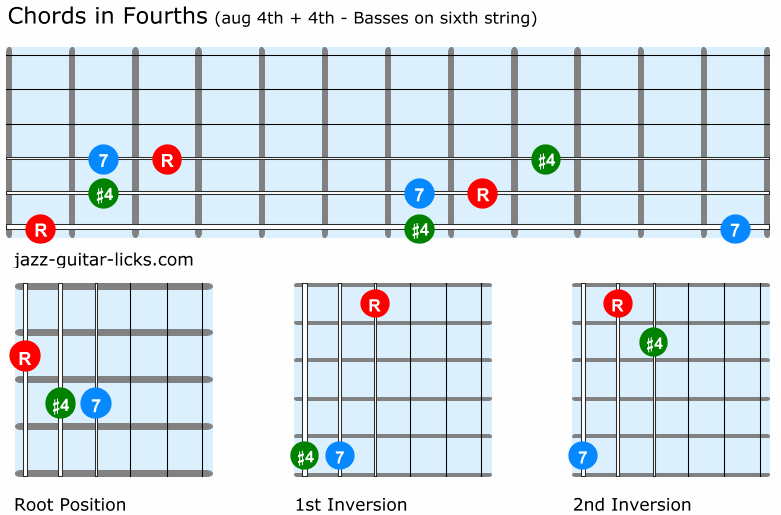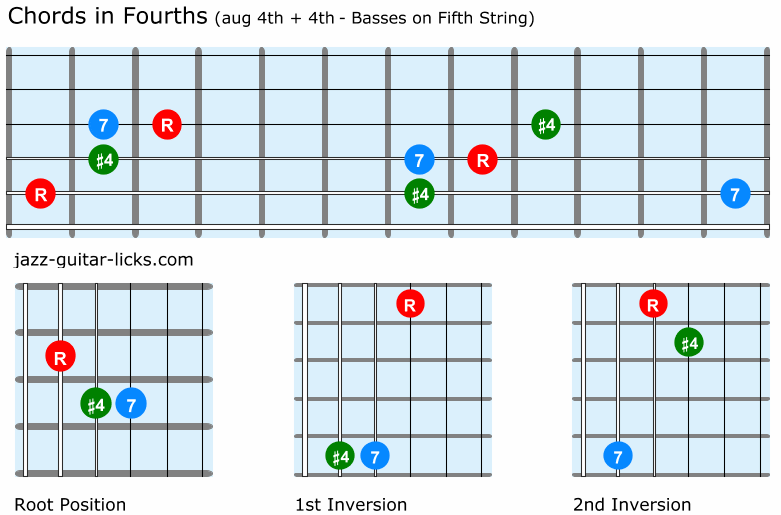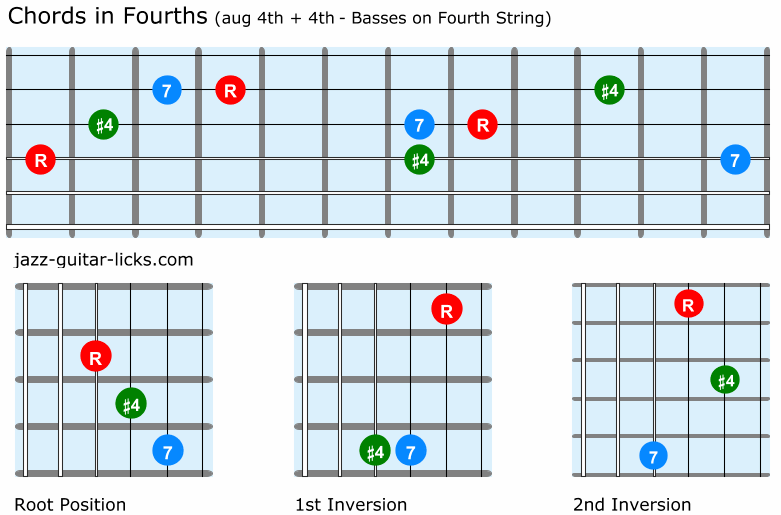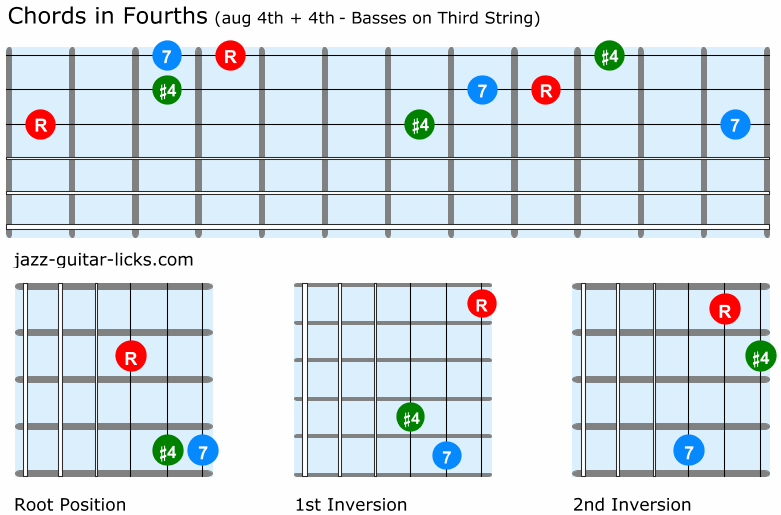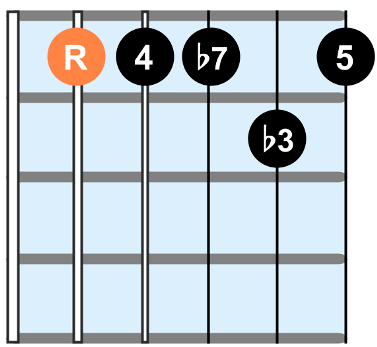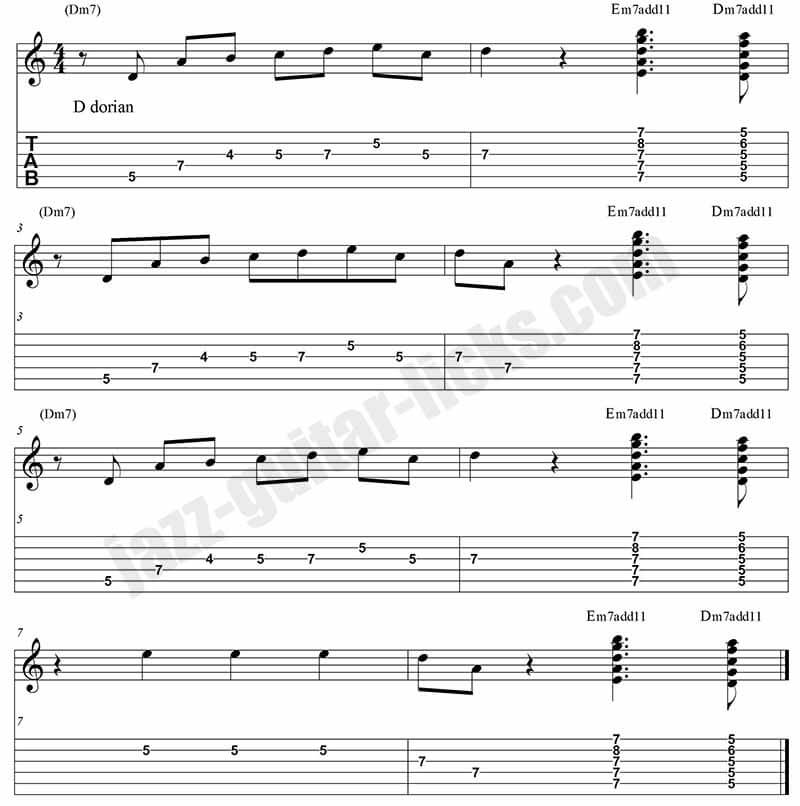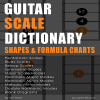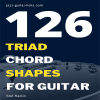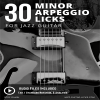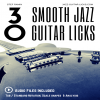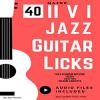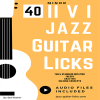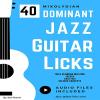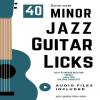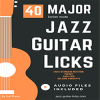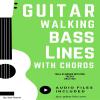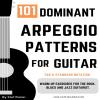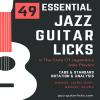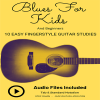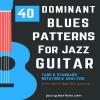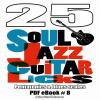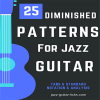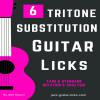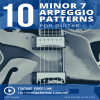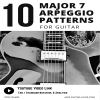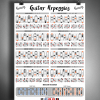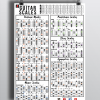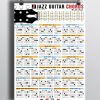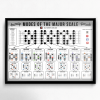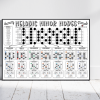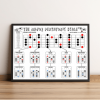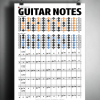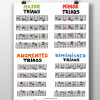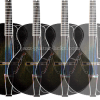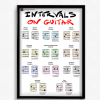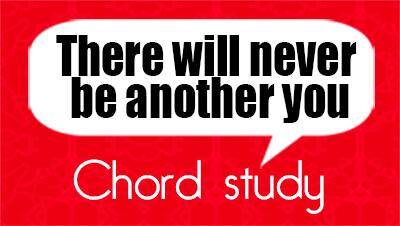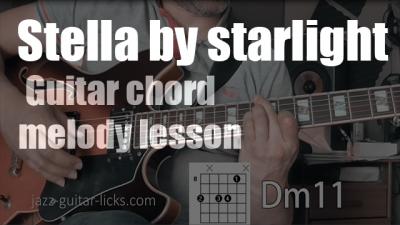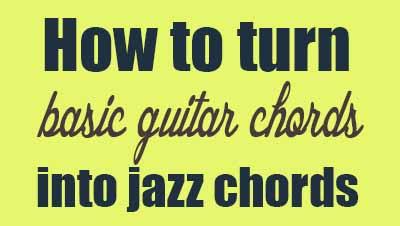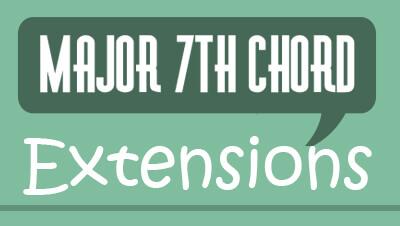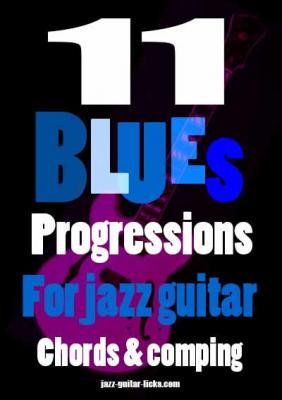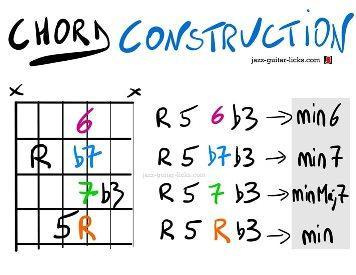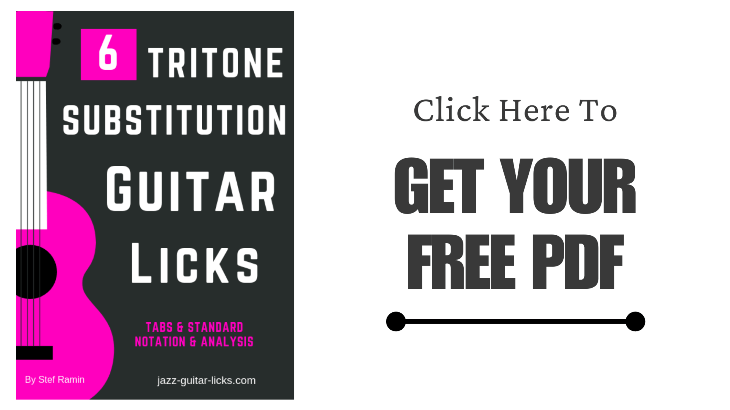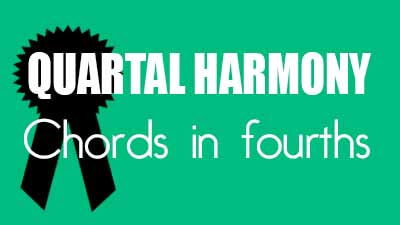
Chords in Fourths - Quartal Harmony
- By jazz-guitar-licks
- On 2017-01-07
- 2 comments
What is Quartal Harmony?
To enrich and modernize the harmonization of a piece it is common to use fourth chords. They can replace some original chords to bring more melodic freedom into improvisation and more tension in harmony.
Since the late 1950s, harmony in fourths has played a very important role in the development of modern jazz. Musicians and composers have used a lot the quartal harmony.
Among them, the great American pianist McCoy Tyner, who, is a master in the art of playing quartal chords. Mike Stern, Herbie Hancock, Chick Corea, Bill Evans and Kurt Rosewinkel have also used this technique.
In this lesson with tabs and shapes, we will see how to build chords in fourths, how to harmonize the major scale with and how to use them in comping.
How to Build Chords in Fourths ?
Basically, chords are built by stacking thirds. If you don't master this fundamental theoretical element, it is, therefore preferable to go to see the lesson about how to harmonize the major scale in thirds
What's a Fourth Interval ?
An interval is the distance between two notes. There are two kinds of fourth intervals :
- A perfect fourth (4) is built with five semitones, it is either considered major or minor. For example, D is 5 semitones away from G. This is a perfect fourth interval.
- An augmented fourth (aug4) is constructed with 6 semitones. Example with F and B.
What's a Fourth Chord ?
A fourth chord, also called quartal chord, is a chord built with fourth intervals. There can be three types of fourths chords :
- Built by stacking 2 perfect fourths (4 + 4). This is the basic fourth chord.
- Built by stacking 1 perfect fourth and an augmented fourth (4 + aug4).
- Built by stacking an augmented fourth and a perfect fourth (aug4 + 4) .
Basic Fourth Chords - Voicings - Root Positions and Inversions
Building a three-note chord built in fourths in its pure form is quite easy. Starting from the fundamental, you just have to stack notes separated by intervals of perfect fourths. Example with C.
- C (the fundamental)
- F (11) is the fourth of C (5 semitones away from C).
- Bb (M7) is the fourth of F (5 semitones away from F).
When stacking these three notes, we obtain a three-note chord built in fourths C-F-Bb.
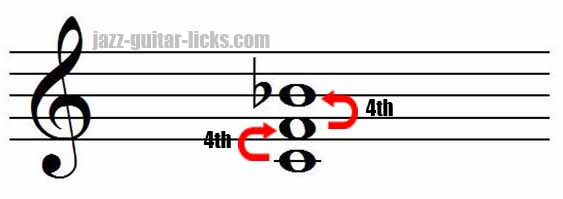
Here are the fourth chord voicings and their respective guitar diagrams with basses on 6th, 5th, 4th and 3rd strings.
| Fourth chord (root position) | 1 (R) | 11 (4) | b7 |
| 1st inversion | 11 (4) | b7 | 1 (R) |
| 2nd inversion | b7 | 1 (R) | 11 (4) |
How to Harmonize the Diatonic Major Scale in Fourths?
All the chords from the harmonized major scale are made up of perfect fourths (4th + 4th). Except for the I and IV degrees because of the harmonization, are respectively built with 4th + aug4th and aug4th + 4th.
That implies 8 other fourth chord positions that all have two possible inversions:
Fourth chords made of 4th + aug4th
These four positions are related to the degree I of the major scale. They are built by stacking a perfect fourth and an augmented fourth.
| Fourth chord (perfect 4th + augmented 4th) | 1 (R) | 4 (11) | 7 |
| 1st inversion | 4 (11) | 7 | 1 (R) |
| 2nd inversion | 7 | 1 (R) | 4 (11) |
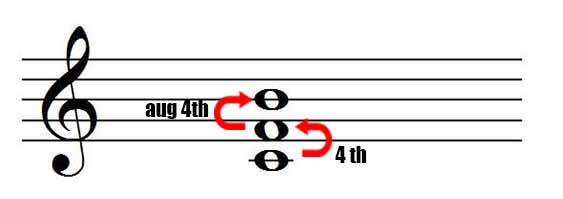
Fourth chords made of aug4th + 4th
The four following guitar diagrams are related to the degree IV of the major scale. They are built by stacking an augmented fourth and a perfect fourth.
| Fourth chord (augmented 4th + perfect 4th ) | 1 (R) | #4 (#11) | 7 |
| 1st inversion | #4 (#11) | 7 | 1 (R) |
| 2nd inversion | 7 | 1 (R) | #4 (#11) |
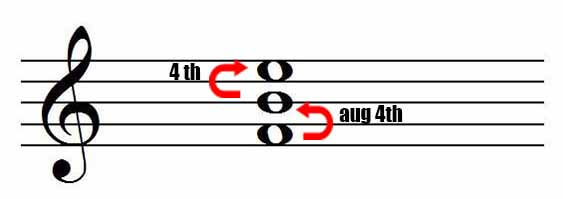
Quartal harmony yields a somewhat harmonically ambiguous sound because the voices have a less direct relationship to the root of the chord. It is difficult to indentify a tonal center with chords built in fourths. There can be more than one chord quality for a fourth chord.
Adding a Supplementary Fourth | Four-note Chords in Fourths
Adding another fourth in addition to the three-note chords previously seen will help you create more interesting chords. The added tone forms an interval of a tenth with the bass note.
It can be considered as a redoubled third (We call a redoubled interval, a simple interval carried in its octave). This note can be b10 or 10 (major or minor third) depending on the harmonization.
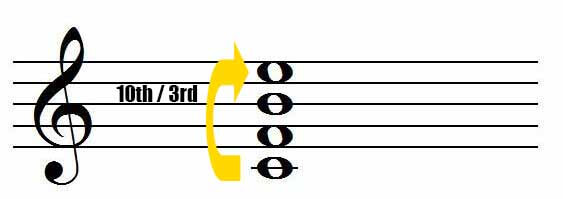
Adding the Third - So What Chord
The "so what chord" is a modern sounding voicing often used as an alternative to quartal voicings.
It consists of a fourth chord (in its pure form) and a major third added on the top of the chord. In other words, three perfect fourths and a major third are stacked.
The origin of its name would be due to its use by Bill Evans in the head of "So what" by Miles Davis.
Here is an illustration of the "so what" chord. This one can be named Em7add11.
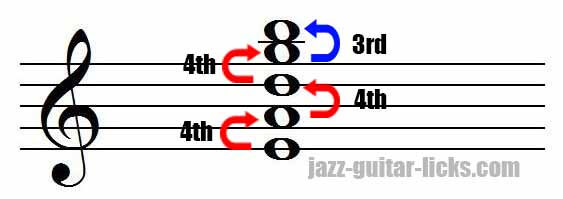
| Em7add11 | E | A | D | G | B |
| Intervals | 1 | 11 (4) | b7 | b3 | 5 |
The "So what chord" is identical to the standard tuning of the five lowest strings of the guitar. (E-A-D-G-B). Some teachers and music methods named this chord m11 , but theoretically m11 chords must contain a 9.
That is not the case here, so what chords are made up of 1, 4, b7, b3 and 11. It is preferable to name them m7add11.
So What - Miles Davis - Guitar Transcription
So what, by Miles Davis, from the best selling jazz album of all times (Kind of blue) is surely one of the most popular modal jazz tunes.
It is an AABA form centered around the D Dorian mode and modulating from Dm to Ebm. Chord progression consists of 16 bars of Dm7, 8 bars of Ebm7, and 8 bars of Dm7.
It is fairly simple to play, to understand because there are no harmonic progressions, this is the principle of modal tunes.
First, the theme is played by the bass and then the two "So what chords" are played by the pianist (Bill Evans).
Once you have mastered this, you have to play the same lines and chords a half-step up (Ebm).
This way Em7add11 becomes Fm7add11 and Dm7add11 becomes Ebm7add11.
Impressions - John Coltrane - McCoy Tyner Piano Comping Arranged For Guitar
There are other examples of "So what chords" in "Impressions" by John Coltrane. McCoy Tyner was fond of this quartal harmonization. The chord progression is the same as "So what" (16 bars of Dm7, 8 bars of E♭m7, and 8 bars of Dm7).
There are many ideas of comping to pick up, so listen carefully and try to transcribe them. For the time, here are three examples using "So what chords" taking from "Impressions".
Example 2
A Fmaj7 is added between Dm7add11 and Em7add11. You can visit this page to see how to play major seventh chords on the guitar.
Impressions - John Coltrane
John Coltrane - Impressions (Complete)
Tracklisting
| A1 | India | 13:52 |
| A2 | Up 'Gainst The Wall | 3:12 |
| B1 | Impressions | 14:40 |
| B2 | After The Rain | 4:07 |
- Bass – Jimmy Garrison, Reggie Workman (tracks: A1)
- Bass Clarinet – Eric Dolphy (tracks: A1)
- Composed By – John Coltrane
- Design [Cover] – Robert Flynn (2), Viceroy (2)
- Design [Liner] – Joe Lebow
- Drums – Elvin Jones (tracks: A1 to B1), Roy Haynes (tracks: B2)
- Mastered By – RUDY VAN GELDER*
- Photography By [Cover And Liner Photos] – Joe Alper
- Piano – McCoy Tyner
- Producer – Bob Thiele
- Soprano Saxophone – John Coltrane (tracks: A1)
- Tenor Saxophone – John Coltrane (tracks: A2 to B2)
Source / Discogs
Impressions - Backing tracks
Impressions - John Coltrane - Modal jazz backing track
Impressions - Bass jazz backing track - John Coltrane
Impressions - Piano backing track - Modal jazz - John Coltrane
-
Guitar Scale Dictionary
This E-book is a printable PDF method including over 700 scale diagrams and formula charts for guitarists. -
30 Groovy Jazz Guitar Licks
This downloadable package contains a PDF WITH audio files giving access to 30 groovy guitar phrases mixing jazz, blues and funky licks for beginners. -
Guitar Chord Dictionary
This PDF eBook provides over 550 guitar chord shapes. This is the perfect reference guide to understand how chords are built and how to play them on the guitar neck. -
172 Arpeggio Shapes For Guitar
This printable PDF is a method dedicated to guitarists of all styles who want to learn the most important types of arpeggios. -
126 Triad Chord Shapes
This handbook for guitar players is intended both for teachers and students. It includes 126 guitar shapes for mastering triads. -
30 Minor Arpeggio Licks
This package includes a printable PDF method containing 30 exercises with tabs, staves and audio files for practicing minor arpeggios on guitar. -
II V I Bundle - 170 Exercises
This bundle contains 4 PDF methods for a total of 170 exercises with tabs, staves, analysis & audio files for practicing scales, arpeggios licks & chords over the 2-5-1 progression. -
Diatonic Licks Bundle
This package contains 120 jazz guitar lines based on diatonic modes as Mixolydian, Dorian and Ionian. PDF format with tabs, audio files and analysis. -
30 Smooth Jazz Guitar Licks
In this package you'll get a printable PDF Method with tabs, notation, analysis, scale shapes and audio files for practicing 30 smooth jazz guitar licks. -
40 II V I Jazz Guitar Licks
This pdf method for guitar contains fourteen 2 5 1 jazz guitar lines with tab, standard notation, analysis, scale charts and audio files. -
50 II-V-I voicings
This printable PDF guitar method provides 50 exercises with audio files, analysis, tab and staves for learning major 2-5-1 chord voicings. -
40 Minor 2 5 1 Chord Voicings
This PDF method contains 40 exercices with tabs, scores and audio files for practicing jazz guitar chords over the minor 2 5 1 progression. -
40 Minor II V I Licks
This guitar method is a printable PDF with tabs, diagrams, theory and audio files providing 40 minor 2 5 1 jazz patterns. -
40 Mixolydian Jazz Guitar Lick
PDF guitar method with tabs, audio files and theory providing 40 dominant jazz guitar lines for teachers and students. -
40 Minor Jazz Guitar Licks
This printable guitar method in PDF format contains 40 easy minor jazz guitar lines based on the Dorian mode. -
40 Major Jazz Guitar Licks
Printable PDF eBook method containing 40 major jazz guitar licks with tab, standard notation and audio files for beginners and intermediates. -
Guitar Walking Bass Lines
This jazz guitar method about walking bass lines and chords is available as a PDF files containing 35 exercises with tabs, analysis and audio files -
101 Dominant Arpeggio Patterns
This printable PDF method provides 101 dominant arpeggio exercises with tab, theory and standard notation for the jazz, blues and rock guitarist. -
49 Essential Jazz Lines
This printable eBook method in PDF format provides 49 jazz solo transcriptions of the greatest jazz musicians. Tab, standard notation, audio files & analysis. -
11 Jazz Blues Studies
11 jazz blues chord studies with tabs, standard notation, analysis, and audio recordings and PDF. -
10 Easy Fingerstyle Blues
This PDF with Tabs and audio files provides 10 easy acoustic fingerstyle blues guitar studies for kids and beginners. -
25 Altered Jazz Guitar Lines
This PDF eBook method contains 25 altered jazz guitar licks with tabs, patterns, scale charts and audio files to master, apply and develop the altered scale. -
40 Blues Dominant Patterns
This printable method is available as a PDF file containing 40 easy dominant jazz-blues guitar lines with tabs, standard notation, analysis, audio files and scale charts. -
Mastering Pentatonic Scales
This jazz guitar method is an eBook available as a PDF with standard notation, guitar tabs, diagrams, analysis, audio files and backing tracks. You will find in this booklet 25 easy jazz guitar lines with theory using common and rare pentatonic scales. -
25 Soul Jazz Guitar Licks
You will find here an eBook available in PDF containing 25 soul jazz and hard bop guitar licks in the style of Grant Green, Melvin Sparks, George Benson. These jazz lines come with tabs, standard notation, guitar neck diagrams, backing track for practice and 25 audio files for each riff. -
25 Diminished Patterns
This eBook PDF with audio files contains 25 dominant diminished jazz guitar patterns using the half-whole diminished scale and diminished 7th arpeggios. -
6 Tritone substitution licks
This Printable PDF eBook available for free download contains 6 easy jazz guitar licks with tabs/notation, youtube video link and analysis about the tritone substitution. -
10 Minor 7 Arpeggio Patterns
This printable PDF eBook offers 10 easy minor 7 arpeggio patterns with its related YouTube video for beginner guitarists. -
10 Easy Major 7 Arpeggio Licks
This is a printable PDF for beginner jazz guitar players providing 10 easy licks to practice major 7 arpeggios. -
10 Chord Melody Lines
Within this package, you'll discover a set of ten chord melody exercises for beginners. Printable PDFaudio files, a backing track, and a link to the associated YouTube video. -
10 Minor Blues Scale Licks
You'll find here a PDF with 10 easy jazz guitar licks to practice the minor blues scale on guitar.
-
Guitar Arpeggios Poster
This giant guitar poster for any guitar player, student or instructor contains colorful arpeggio diagrams. Giant size 24 x 36 inches (60 x 90 cm). -
Guitar Scales Poster 24*36
Guitar posters and wall art with eighteen neck diagrams representing the most used scales in music. -
Jazz Guitar Chords Poster
This printed color posters contains 63 guitar chord diagrams for jazz players, students, teachers and schools. -
Guitar Modes Poster
Guitar reference posters and wall art about modes of the major scale for guitar teachers, students and music schools. -
Melodic Minor Modes Poster
Educative and decorative giant guitar poster with neck diagrams, interval names about the seven modes of the melodic minor scale. -
Pentatonic Scale Guitar Poster
This guitar reference poster shows the positions and intervals of the major pentatonic scale. -
Guitar Notes Poster
This is a giant poster showing the notes on the guitar fret board and their positions on a musical staff. -
Triads Guitar Poster
This reference poster show the positions and intervals of the main triads used on guitar. This is a useful tool for guitarists, teacher and students. -
Four Archtop Guitars Poster
This is a decorative poster with four archtop jazz guitars. Several size and colors in landscape format available on Teespring and redbubble. -
Intervals On Guitar - Poster
This giant poster for guitar provides neck diagrams with interval positions.
guitar lesson jazz guitar lesson jazz chords guitar chords jazz guitar chords chords quartal harmonization Harmonizing in fourths music theory Quartal chords
Comments
-

- 1. qiqe On 2018-05-15
it´s perfect-
- jazz-guitar-licksOn 2018-05-15
Glad you like it
Add a comment
